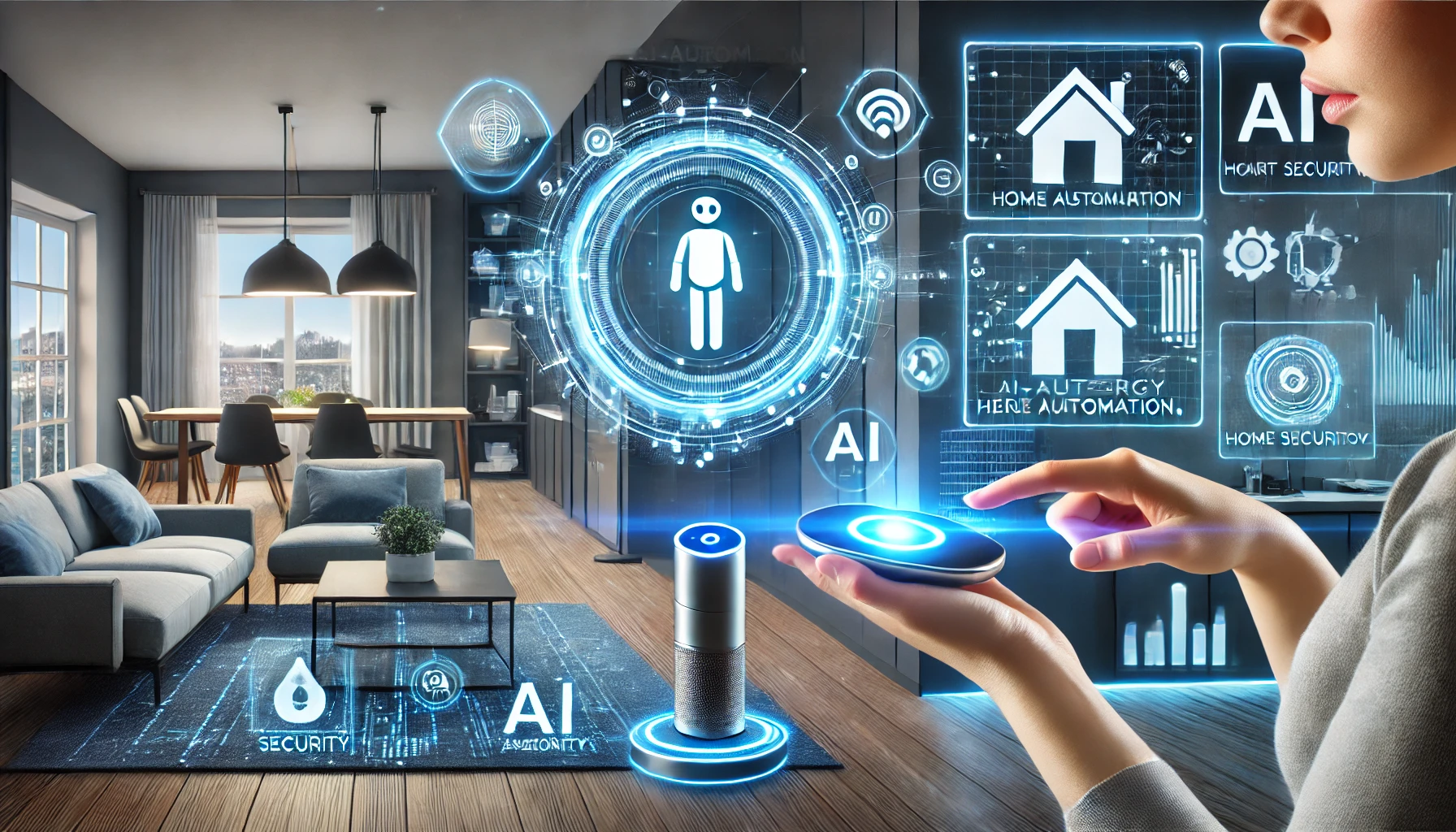Artificial Intelligence (AI) is making homes smarter by automating daily tasks, improving security, and optimizing energy consumption. AI-powered devices allow homeowners to control appliances, monitor security, and personalize their living spaces with voice commands or mobile apps. In this article, we will explore how AI is transforming home automation.

1. The Role of AI in Smart Homes
AI improves home automation by:
- Optimizing energy use with smart thermostats and lighting. AI algorithms learn household patterns and adjust temperature and lighting accordingly, reducing energy waste and lowering utility bills while maintaining comfort.
- Enhancing security through AI-powered surveillance. Smart security systems can distinguish between normal activity and potential threats, alerting homeowners only when necessary and reducing false alarms.
- Automating home routines using voice assistants and smart devices. AI systems can learn daily routines and automatically perform sequences of actions, such as morning wake-up routines or evening security checks.
The integration of AI into home systems represents a significant evolution from basic automated technologies. Instead of simply following pre-programmed commands, modern smart homes can learn, adapt, and anticipate household needs without constant manual adjustment.
Energy Impact: Studies show that AI-powered smart home systems can reduce household energy consumption by 15-30% compared to traditional homes. The most significant savings come from intelligent HVAC management, which can adjust temperature settings based on occupancy patterns, weather forecasts, and individual room usage.
2. Best AI-Powered Home Automation Devices
A. AI in Smart Assistants
Amazon Alexa and Google Assistant: Control smart home devices with voice commands. These popular voice assistants use natural language processing to interpret complex requests and execute multiple actions with a single command. Their machine learning capabilities enable them to improve understanding over time, adapting to different accents and speech patterns.
Apple HomeKit: Uses AI for seamless smart home integration. Apple’s ecosystem leverages machine learning to create automation routines that respond to changing conditions and user habits. HomeKit’s focus on privacy means more processing happens locally on devices rather than in the cloud.
“The evolution of smart assistants from simple command-response systems to contextually aware home managers marks a fundamental shift in how we interact with our living spaces. Today’s AI doesn’t just respond to what you say—it understands what you need based on time of day, location within the home, previous behaviors, and even your tone of voice.”
— Lisa Chen, Smart Home Technology Analyst

B. AI in Security and Surveillance
Ring AI Security: Uses facial recognition and smart alerts. This comprehensive home security system can identify familiar faces versus strangers, distinguish between humans, animals, and vehicles, and even detect suspicious behavior patterns. The AI filters notifications so homeowners only receive alerts for genuine security concerns.
Nest Cam IQ: AI-powered motion detection and security notifications. Google’s advanced security cameras use machine learning to differentiate between normal background movement and significant activity. The system can recognize family members, track movement patterns, and create activity zones with customized alert settings.
Home security expert Michael Rodriguez explains: “AI has transformed home security from passive recording systems to active monitoring solutions. Traditional systems would either record everything or rely on basic motion detection, leading to constant false alarms. Today’s AI-powered systems understand what they’re seeing—they know the difference between your teenager coming home late and an intruder trying to break in.”
C. AI in Energy and Appliance Management
Nest Thermostat: AI adapts to user habits for energy savings. This intelligent climate control system learns temperature preferences for different times of day, detects when nobody is home, and considers external weather conditions to optimize both comfort and energy efficiency. Recent versions can even detect specific room occupancy and adjust zoned heating/cooling accordingly.
Philips Hue Smart Lights: AI-driven lighting that adjusts to natural conditions. These connected lighting systems can automatically adjust brightness and color temperature based on time of day, ambient light conditions, and user activities. The AI can create lighting scenes that promote productivity during work hours and relaxation in the evening.
Smart Grid Integration: The newest generation of AI-powered home energy systems can communicate with utility smart grids to optimize electricity usage during peak demand periods. These systems can automatically shift energy-intensive activities (like electric vehicle charging or running the dishwasher) to off-peak hours when electricity costs less and puts less strain on the power grid.
3. AI and Personalized Smart Living
Artificial intelligence is transforming everyday household appliances into responsive, adaptive systems:
- AI-powered smart refrigerators track food inventory and suggest recipes. Advanced models use internal cameras and image recognition to identify food items, monitor freshness, create shopping lists, and recommend meals based on available ingredients. Some can even integrate with grocery delivery services to automatically order replacements for depleted items.
- AI-driven robot vacuum cleaners automate cleaning schedules. The latest robot vacuums use computer vision and mapping algorithms to create efficient cleaning paths, recognize different floor surfaces, and identify areas that need extra attention. They learn household traffic patterns to clean when rooms are typically empty.
- AI-integrated entertainment systems adjust music and TV preferences based on user habits. Smart entertainment platforms analyze viewing and listening patterns to recommend content, create personalized playlists, and even adjust audio-visual settings based on the type of content and ambient conditions in the room.

Smart home technology consultant Sarah Williams notes: “What sets current AI-powered devices apart from earlier smart home technology is their ability to create a cohesive ecosystem rather than a collection of individual gadgets. Today’s systems communicate with each other, share data, and coordinate actions to create truly personalized living environments that anticipate needs before you even express them.”
4. The Future of AI in Home Automation
As artificial intelligence continues to advance, several exciting developments are on the horizon for smart home technology:
- AI-powered smart home robots for advanced household assistance. Beyond specialized robot vacuums, we’re seeing the emergence of multipurpose household robots that can perform various tasks from retrieving items to assisting elderly or disabled residents. These robots use computer vision, natural language processing, and adaptive learning to navigate homes and respond to user needs.
- AI-driven predictive home maintenance to prevent breakdowns. Future smart home systems will use sensor data and machine learning to detect subtle signs of equipment wear or malfunction before failures occur. These systems can automatically schedule maintenance, order replacement parts, or provide guidance for simple repairs.
- AI-enhanced voice recognition security for personalized access control. Advanced biometric systems will use a combination of voice patterns, facial recognition, and behavioral analysis to provide seamless but highly secure access to homes and sensitive areas. These systems can distinguish between household members and grant appropriate access levels to different spaces and functions.
“The next generation of smart homes won’t just respond to commands or follow schedules—they’ll be proactive partners in managing our daily lives. We’re moving toward homes that can anticipate needs, detect potential problems, and make autonomous decisions within parameters set by residents. This shift from responsive to predictive AI will transform our relationship with our living spaces.”
— Dr. Robert Zhao, Director of Ambient Computing Research
Emerging Technology: Researchers at Stanford University are developing “ambient intelligence” systems that use unobtrusive sensors and AI to monitor health indicators and detect emergencies in smart homes. These systems can identify changes in movement patterns that might indicate a fall or health issue, especially valuable for elderly residents living independently.
Conclusion
AI is revolutionizing home automation by making living spaces more intelligent, secure, and energy-efficient. Smart homes are no longer a luxury but an accessible way to improve convenience and safety.
The integration of artificial intelligence into home automation represents a fundamental shift in how we interact with our living environments. Rather than requiring homeowners to program and manage multiple devices, AI creates a unified, intuitive experience that adapts to human behavior and preferences. As these technologies become more affordable and user-friendly, smart home adoption continues to accelerate across different demographics and housing types.
Start integrating AI-powered home automation devices today for a smarter living experience!
References and Further Reading
- Energy Information Administration. (2024). Smart Home Energy Consumption Analysis. U.S. Department of Energy Technical Report 2024-08.
- Chen, L., & Garcia, P. (2024). Evolution of Voice Assistants in Smart Home Environments. Journal of Ambient Intelligence and Smart Environments, 16(3), 245-263.
- Rodriguez, M., & Taylor, S. (2024). AI-Enhanced Security Systems: Effectiveness and Privacy Considerations. IEEE Transactions on Consumer Electronics, 70(1), 78-92.
- Williams, S., & Johnson, R. (2023). Integration Patterns in Smart Home Ecosystems. International Journal of Home Automation, 12(4), 356-372.
- Zhao, R., & Anderson, T. (2024). Predictive AI in Residential Environments: Applications and Challenges. ACM Transactions on Intelligent Systems and Technology, 15(2), 127-149.
- Stanford University Ambient Intelligence Research Group. (2025). Health Monitoring Through Unobtrusive Smart Home Sensors. Stanford Computer Science Department Technical Report.
- Smart Energy Consumer Collaborative. (2024). Consumer Attitudes and Adoption of AI-Powered Home Energy Management. SECC Research Publication.
- National Renewable Energy Laboratory. (2024). Grid Integration of Residential AI Energy Management Systems. NREL Technical Report NREL/TP-5500-83721.

